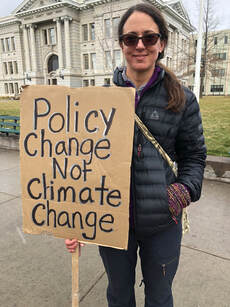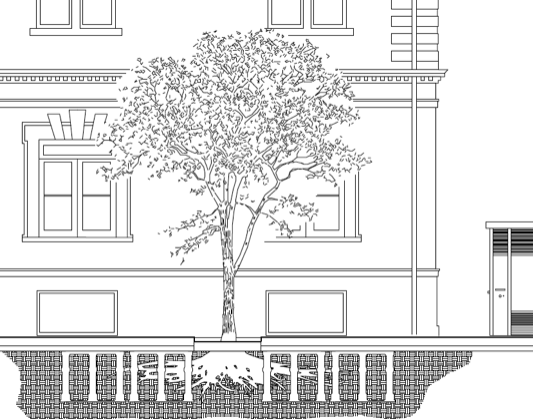|
Over the next several weeks, we'll be sharing letters for our DearTomorrow project. We hope you'll read, get inspired, then write your own! It's a great way to commit to taking action in 2020 and motivate and engage others in our community.  My Children, I am sitting here writing this letter on a quiet Sunday afternoon. The wind is gusting, blowing the piles of leaves into the air and depositing them in dusty, forlorn and forgotten corners. The leaves, most of them still clinging to the trees, crinkly and brown, are unwilling participants in the changing climate. A reminder of the record breaking cold snap from last month, having frozen them in place, denying them their time of glory and natural order of business. The subtle ringing of the wind chimes, a harbinger of the cold front that is moving in. The weather is as unsettled as I am. I fear for your future and what it may bring. I used to dream of grandchildren, now I no longer do. I don't want you to have to carry the burden of bringing children into this devastatingly sad, changing and unknown world. Will you have the ease of life that we do now? Will you have secure food, jobs, the ability to travel and adventure as I did in my youth? Will you be able to watch the confident and gregarious chickadees at the feeder, frantically filling up with food in order to survive the upcoming frigid night? I’ve just read that they are one of the many bird species that are slated to disappear here in Montana. Will you be able to spend your summers outside, or will they be spent escaping the choking smoke from wildfires? Will you be able to observe the docile bumble bee, fuzzy backside protruding from the flowers? The remaining ones are now endangered, many species already extinct. I’ll continue to plant their beloved flowers and fill up the colorful bee bath daily, hoping that it makes a difference. Gabe, will the rivers run dry in summer heat? Will you be able to spend your summers in frigid, swirling waters stalking the elusive trout that you love so much? The water flow in our rivers and streams are running lower now. Mica, will you be able to climb the high peaks in search of your beloved pikas? Is it too late? They are running out of the higher elevations on their mountain top homes to escape from the increasingly oppressive heat of summers. When will there be nowhere else for them to go? Mayana, will you be able to seek your peace and quiet in the woods around your home, wandering thoughtfully and observantly? Reading in the hammock while the warm summer breezes cool your damp skin? Or will the ponderosa and aspen trees no longer have the precipitation needed to grow. Instead, will you have treeless, dry hillsides to wander on? I read that this may be the case. I was told that we need to prepare ourselves for a changing landscape as trees make way for grasslands. Forest fires will instead become grass and scrubland fires. This is why I act. Not because I want to, but because I must. Doing exactly what introverts find so hard. But I do it for you and those who come after me. For the animals and plants, the trees and the rivers. I must hope that it will be enough, otherwise it becomes too much to contemplate. For now I act. And make plans. Plans to visit the places that are disappearing, that your children will never see, and the places that you may not get a chance to experience if we don’t go soon. The special places of my youth. Already changed, remnants of what they once were, but still hanging on. To see, touch, and smell the receding glaciers. The birds and flowers. The pikas living above the tree line, frantically preparing for a winter that they hope will still come. For you my children, I hope. This letter submitted by Rachel K in Missoula. Submit your letter online today.
0 Comments
The other day, I was talking to someone who recently moved to Missoula from the southwest. “There are so many trees here!” she exclaimed. Missoula does have a lot of trees - over 30,000 just on city-owned right of ways! - but that fact is no happy accident. The robustness of our urban forest is a result of dedicated folks in local government, community advocacy organizations, and regular citizens who are committed to keeping this cornerstone of our local ecosystem thriving. And it’s not just trees, either - it’s shrubs and grasses and native plants of all kinds in our urban and surrounding areas that contribute ecological diversity, habitat, and ecosystem services that support climate resiliency and community health. Urban forestry was the focus of October’s monthly meetup, and we were thrilled to be joined by Marie Anderson with the City of Missoula’s Urban Forestry division and Karen Sippy with Trees for Missoula. As always, the conversation was wide ranging and inspiring, but also raised plenty of questions and highlighted opportunities to do more on this issue. Trees as a climate solution Trees in particular have recently occupied headlines as researchers have attempted to calculate just how much potential they have to store carbon. We know there’s no silver bullet when it comes to climate action (if hunting season metaphors are your thing, climate solutions are more like silver buckshot). But it’s no wonder people are excited about trees: they have a whole host of benefits beyond taking CO2 out of the air. Here in Missoula, Climate Smart has partnered with the City and County over the last year and a half on a comprehensive Climate Resiliency Planning process, and it turns out that trees - and shrubs and green infrastructure - are so integral to building our community’s climate resilience that they are part of 8 out of 9 sectors represented in the plan (draft to be released this fall for community input - stay tuned!). Growing our urban forest and green infrastructure: education Whether on public land or private, how do we maintain the health of our urban forest given its importance to ensuring a climate-resilient Missoula? As with so many things, education is key. Some of the education that’s needed is at the citizen level: for example, Trees for Missoula has been working to ensure residents have all the information they need to care for new trees that have been planted on city boulevards, which are generally the responsibility of adjacent property owners - not everyone knows this! Even well-meaning folks with water conservation in mind don’t always know that watering trees and shrubs (and yes, even reasonably-sized lawns!) is okay here, because excess water generally makes its way through our porous valley soils and back into the resilient Missoula Aquifer under our feet. In fact, many of our street trees (there are over 116 species in our public urban forest!) require additional water beyond annual rainfall. Learn more about watering trees HERE. We can also improve education within our schools. Kids may learn about trees in biology class or understand how they take in CO2 and provide oxygen for us to breathe, but the practical tools to grow and care for trees are a gap that Trees for Missoula and the City Forestry department are working to fill with a new educational course for Big Sky High School’s agricultural cohort. This class has the potential to be replicated in other schools, so kids across our community are equipped to be tree stewards. Education is also needed within local government agencies tasked with supporting our urban green spaces and builders and developers. The good news is that this education is happening, and even within the last few years, there’s been a shift in how city departments consider green infrastructure, from planning to development to permitting, Missoula Water to Development Services and engineering. Going forward, it’s even more essential to integrate these kinds of climate resiliency considerations into development and redevelopment projects. Silva cells are an interesting example of this: a “suspended pavement system” that allows sidewalk trees to root much more deeply and thrive, Marie and Karen shared how this technology is now becoming the default for many of the redevelopment projects downtown, where more trees can help make pedestrian areas cooler and actually extend the lifetime of asphalt and pavement.
|
AuthorsAbby Huseth Archives
July 2024
Categories
All
|


 RSS Feed
RSS Feed


